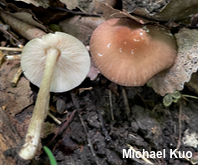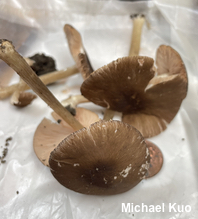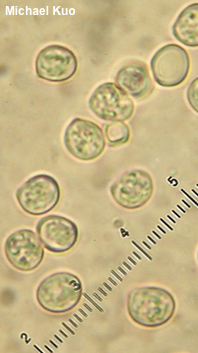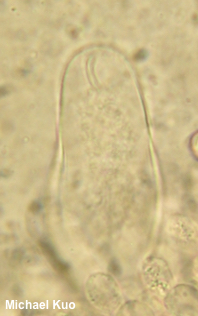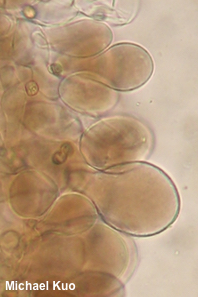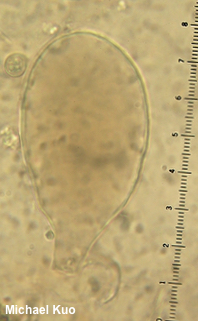| Major Groups > Gilled Mushrooms > Pink-Spored > Pluteus > Pluteus deceptivus |

|
[ Basidiomycota > Agaricales > Pluteaceae > Pluteus . . . ] Pluteus deceptivus by Michael Kuo, 4 September 2023 Pluteus deceptivus is a rarely documented species first collected by North American mycologist Alexander Smith in 1942, in Washtenaw County, Michigan. Smith thought his collection represented a new species, but never officially published the idea. His collection was later studied by Pluteus specialists (Richard Homola in the seventies; Drew Minnis in the two-thousands), both of whom agreed that it was not described elsewhere in Pluteus literature. Minnis published the species in 2010 as "deceptivus" because of "the difficulty both historical and in practice of identifying this fungus." Macroscopically Pluteus deceptivus features a notably "rimose" cap surface—meaning it soon becomes radially cracked, with whitish flesh showing through the cracks. It is medium sized (for a Pluteus), and it appears to prefer wet woods (lowlands, riverine ecosystems), where it arises from buried woody debris under hardwoods. Under the microscope the species is more distinct; look for scattered utriform pleurocystidia, broadly ellipsoid spores, and a hymeniform pileipellis that features swollen brown elements, some of which get quite large (longer than 60 µm and wider than 40 µm). Description: Ecology: Saprobic on the buried debris of hardwoods in low, damp woods, appearing terrestrial; growing alone or gregariously; summer and fall; originally described from Michigan (Homola 1969); distribution uncertain. The illustrated and described collection is from Illinois. Cap: 3–5 cm; convex, becoming broadly convex; dry; grayish brown; soon becoming radially cracked; the margin not lined. Gills: Free from the stem; close or nearly crowded; short-gills frequent; whitish at first, becoming pink. Stem: 4–7 cm long; 4–6 mm thick; tapered slightly to apex; bald or very finely and sparsely fibrillose; brownish; basal mycelium white. Flesh: White; unchanging when sliced. Odor: Not distinctive. Chemical Reactions: KOH on cap surface negative. Spore Print: Brownish pink. Microscopic Features: Spores 5–7 x 5–5.5 µm; broadly ellipsoid or nearly subglobose; smooth; hyaline in KOH; inamyloid. Basidia 20–25 x 4–5 µm; clavate; 4-sterigmate. Pleurocystidia 40–75 x 15–25 µm; utriform or widely lageniform; smooth; thin-walled; hyaline in KOH. Cheilocystidia similar to pleurocystidia. Pileipellis hymeniform; elements 25–70 x 20–40 µm, obpyriform to sphaeropedunculate or widely cylindric with a truncated base, brown in KOH, smooth. Clamp connections not found. REFERENCES: A. M. Minnis & W. J. Sundberg, 2010. (Homola, 1972; Minnis & Sundberg, 2010.) Herb. Kuo 07122302. This site contains no information about the edibility or toxicity of mushrooms. |
© MushroomExpert.Com |
|
Cite this page as: Kuo, M. (2023, September). Pluteus deceptivus. Retrieved from the MushroomExpert.Com Web site: http://www.mushroomexpert.com/pluteus_deceptivus.html |
